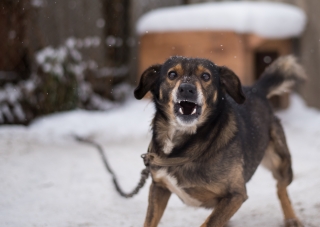Is Your Aggressive Dog Dangerous? Dr. Dunbar Says, Probably Not

This video clip was taken from the new online seminar by Dr. Ian Dunbar: Dog-Dog Reactivity, only available on the Dunbar Academy. Try your first month for just $1.
Do you have an aggressive dog that barks, lunges, snaps, growls, or bites? If so, the next question to ask yourself is:
"Is my dog dangerous?"
Because the answer to this question determines how you should proceed. If your dog is dangerous, you should proceed with caution. We recommend you find professional help from a qualified trainer.
The good news is, most dogs are not dangerous. For the 90+% of dogs who display aggressive behavior but don't do damage, you can start training immediately. Often the traiing for these dogs will be low stress and easy for both ends of the leash and you can and should start training today. This problem will not get better on its own and is much more likely to get worse and worse until you address it.
So, what is a dangerous dog? Some people say every dog is dangerous because every dog is capable of causing harm. We think qualifying dogs this way is pretty silly because it is useless for sorting dogs since it is true of all dogs. Furthermore, with this definition, you can say that almost any object is dangerous because almost any object is capable of causing harm. Balloons and slippers kill a large number of people every year, and you could easily hurt yourself with a coffee mug or a brick, but would you call them "dangerous"?
A far better description of a dangerous dog is one based on the dog's past behavior, not their potential future behavior. Such information is specific to the dog in question and so it will actually be useful in determining your course of action.
The other benefit of a definition that looks at past behavior is that it ignores people's perceptions of the dog. People's perceptions can vary wildly. Some people are afraid of all dogs, and being on the receiving end of aggressive behavior can be quite frightening. Some breeds have bad reputations and larger dogs are usually scarier. If we use people's feelings and perceptions of a dog when we try to determine if the dog is dangerous, we'll get different answers depending on who we ask. We want a definition that will give us consistent answers.
Here's our definition: A dog should be considered dangerous if they have caused significant injury to another creature (usually a person or another dog). Of course, this presents a new question. How do we define "a significant injury." Well, if you want to determine how significant an injury is, you look at the injury itself. This is where my Bite Scale comes in. It allows you to objectively assess the severity of a dog bite.
Most "dog bites" are hardly bites at all. They are aggressive outbursts where the dog snapped and lunged. On the occasions when the dog's teeth made contact with the skin of another creature, very rarely do they break the skin. This is not a significant injury. If that is the extent of your dog's aggression then they have not proven to be dangerous.
Of course, aggressive behavior is unpleasant and also a sign that your dog is suffering psychologically. Also, left unchecked, it will probably escalate. So start training your dog today so they don't upset you or others, and so they can relax and enjoy social encounters.
If your dog has broken the skin while biting, you may have a dangerous dog. If your dog has sent someone to the hospital, or another dog to the vet, and they've required stitches, you probably have a dangerous dog. Check out my Bite Scale for more information, but basically, the more severe the bite, the more dangerous the dog.
Dogs can cause very severe injuries in a fraction of a second. If your dog has inflicted serious bites, they still need rehabilitative training but you should proceed with utmost caution. For the rest of this dog's life you should be aware that they may cause significant injury again. It is up to you to manage this dog safely so they are never given the opportunity to harm another creature again.
When you are looking at a dog that is aggressive towards other dogs, you should also look at their Bite to Fight Ratio. This is the number of times they have bitten another dog compared to the number of times they have been in an aggressive encounter where they had the opportunity to bite. Most dogs have been in many "fights" where they snapped, growled, snarled and bared teeth while tussling with another dog, but in the end, there were no significant bites, and instead only wet fur or tiny nicks. This is wonderful news because it means your dog inhibits their bite even when they are in the heat of a fight. Once again, this dog has shown restraint and should receive immediate training to be rehabilitated.
When you have a dog that has only been in a few fights, and they have caused significant damage in a majority of them, you have a dangerous dog. If you want to do rehabilitative training with this dog you'll have to be extremely careful and even then, you'll have to remain vigilant for this dog's entire life, as they have proven that they are capable of severely hurting other dogs. We would strongly recommend getting help from a qualified professional dog trainer.
To be clear though, most dogs are NOT DANGEROUS. Your dog is probably not dangerous. If you're concerned, look at the data. Loot at their observable behavior and try to come to an objective decision. If your dog isn't dangerous, start training RIGHT NOW. Throw away the dog's food bowl and feed them all their food by hand, classically conditioning them to enjoy the presence of any stimuli they find stressful.




